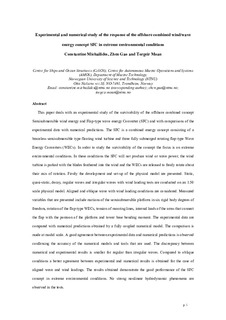| dc.contributor.author | Michailidis, Konstantinos | |
| dc.contributor.author | Gao, Zhen | |
| dc.contributor.author | Moan, Torgeir | |
| dc.date.accessioned | 2017-10-16T08:05:58Z | |
| dc.date.available | 2017-10-16T08:05:58Z | |
| dc.date.created | 2016-07-12T22:07:32Z | |
| dc.date.issued | 2016 | |
| dc.identifier.citation | Marine Structures. 2016, 50 35-54. | nb_NO |
| dc.identifier.issn | 0951-8339 | |
| dc.identifier.uri | http://hdl.handle.net/11250/2460209 | |
| dc.description.abstract | This paper deals with an experimental study of the survivability of the offshore combined concept Semisubmersible wind energy and Flap-type wave energy Converter (SFC) and with comparisons of the experimental data with numerical predictions. The SFC is a combined energy concept consisting of a braceless semisubmersible type floating wind turbine and three fully submerged rotating flap-type Wave Energy Converters (WECs). In order to study the survivability of the concept the focus is on extreme environmental conditions. In these conditions the SFC will not produce wind or wave power; the wind turbine is parked with the blades feathered into the wind and the WECs are released to freely rotate about their axis of rotation. Firstly the development and set-up of the physical model are presented. Static, quasi-static, decay, regular waves and irregular waves with wind loading tests are conducted on an 1:50 scale physical model. Aligned and oblique wave with wind loading conditions are considered. Measured variables that are presented include motions of the semisubmersible platform in six rigid body degrees of freedom, rotation of the flap-type WECs, tension of mooring lines, internal loads of the arms that connect the flap with the pontoon of the platform and tower base bending moment. The experimental data are compared with numerical predictions obtained by a fully coupled numerical model. The comparison is made at model scale. A good agreement between experimental data and numerical predictions is observed confirming the accuracy of the numerical models and tools that are used. The discrepancy between numerical and experimental results is smaller for regular than irregular waves. Compared to oblique conditions a better agreement between experimental and numerical results is obtained for the case of aligned wave and wind loadings. The results obtained demonstrate the good performance of the SFC concept in extreme environmental conditions. No strong nonlinear hydrodynamic phenomena are observed in the tests. | nb_NO |
| dc.language.iso | eng | nb_NO |
| dc.publisher | Elsevier | nb_NO |
| dc.rights | Attribution-NonCommercial-NoDerivatives 4.0 Internasjonal | * |
| dc.rights.uri | http://creativecommons.org/licenses/by-nc-nd/4.0/deed.no | * |
| dc.title | Experimental and numerical study of the response of the offshore combined wind/wave energy concept SFC in extreme environmental conditions | nb_NO |
| dc.type | Journal article | nb_NO |
| dc.type | Peer reviewed | nb_NO |
| dc.description.version | acceptedVersion | nb_NO |
| dc.source.pagenumber | 35-54 | nb_NO |
| dc.source.volume | 50 | nb_NO |
| dc.source.journal | Marine Structures | nb_NO |
| dc.identifier.doi | 10.1016/j.marstruc.2016.06.005 | |
| dc.identifier.cristin | 1367834 | |
| dc.relation.project | Norges forskningsråd: 223254 | nb_NO |
| dc.description.localcode | © 2016. This is the authors’ accepted and refereed manuscript to the article. LOCKED until 27.6.2018 due to copyright restrictions. This manuscript version is made available under the CC-BY-NC-ND 4.0 license http://creativecommons.org/licenses/by-nc-nd/4.0/ | nb_NO |
| cristin.unitcode | 194,64,20,0 | |
| cristin.unitname | Institutt for marin teknikk | |
| cristin.ispublished | true | |
| cristin.fulltext | postprint | |
| cristin.qualitycode | 2 | |

